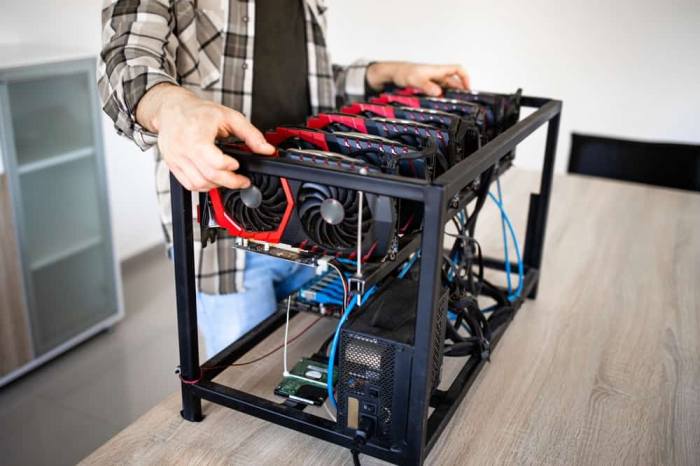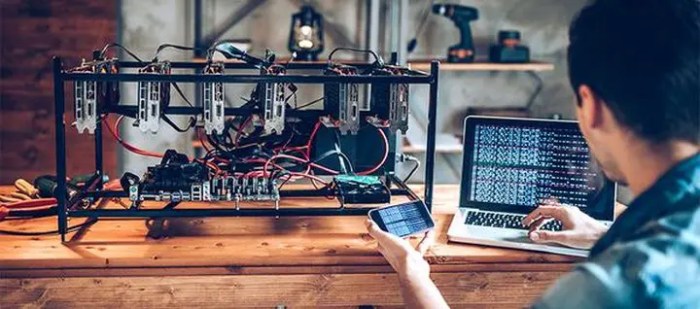How to Start Crypto Mining at Home sets the stage for an exciting journey into the world of digital currency mining. Get ready to dive into the essentials of setting up your own mining rig and maximizing your earnings like a boss!
Understanding Cryptocurrency Mining

Cryptocurrency mining is the process of validating transactions on a blockchain network by solving complex mathematical problems using computer hardware. Miners compete to solve these puzzles, and the first one to do so successfully adds a new block to the blockchain, receiving a reward in the form of newly minted cryptocurrency.
The Role of Blockchain in Mining
Blockchain is a decentralized, distributed ledger that records all transactions made with a particular cryptocurrency. Each block on the blockchain contains a list of transactions, and these blocks are linked together in a chronological order. Miners play a crucial role in maintaining the integrity of the blockchain by verifying and adding new transactions to the ledger.
Importance of Mining in Validating Transactions
- Mining ensures the security and immutability of the blockchain by preventing double-spending and fraud.
- Miners receive transaction fees as incentives for their work, encouraging them to continue validating transactions.
- Without miners, the blockchain network would not be able to function effectively, leading to a breakdown in transaction processing and verification.
Necessary Equipment for Crypto Mining

To start mining cryptocurrency at home, you will need specific hardware components that are essential for the mining process. These components work together to ensure efficient mining operations.
Graphics Processing Units (GPUs)
GPUs are one of the most crucial components for crypto mining, especially for mining popular coins like Ethereum. These high-powered processors are responsible for solving complex mathematical problems to validate transactions on the blockchain. The more GPUs you have, the faster your mining operation will be.
Application-Specific Integrated Circuits (ASICs)
ASICs are specialized hardware designed solely for cryptocurrency mining. These devices are highly efficient at solving the algorithms necessary for mining, making them popular among miners looking for high performance. ASICs are commonly used for mining Bitcoin and other SHA-256 algorithm-based cryptocurrencies.
Power Supply Unit (PSU)
A reliable power supply unit is crucial for crypto mining, as mining rigs consume a significant amount of electricity. It is essential to choose a PSU with sufficient wattage to power all your components efficiently. Additionally, consider investing in a power supply with high energy efficiency to save on electricity costs.
Cooling Solutions
Mining rigs generate a substantial amount of heat while operating, making it essential to have adequate cooling solutions in place to prevent overheating. You can use fans, liquid cooling systems, or open-air rigs to maintain optimal temperatures for your hardware components. Proper cooling can extend the lifespan of your equipment and ensure optimal mining performance.
Setting Up Your Mining Rig: How To Start Crypto Mining At Home
To get started with setting up your mining rig, you will need to follow a series of steps to ensure everything is assembled and configured correctly for optimal performance.
First, gather all the necessary components for your mining rig, including the motherboard, CPU, GPU (Graphics Processing Unit), RAM, power supply, and storage device.
Next, follow these steps to assemble your mining rig:
Assembling Your Mining Rig, How to Start Crypto Mining at Home
- Start by installing the CPU onto the motherboard according to the manufacturer’s instructions.
- Insert the RAM into the appropriate slots on the motherboard.
- Connect the GPU to the motherboard and secure it in place.
- Attach the power supply to the motherboard and GPU.
- Connect the storage device to the motherboard.
- Ensure all components are securely in place and all connections are properly made.
Once your mining rig is assembled, you will need to install mining software on your system. Here’s how you can do that:
Installing Mining Software
- Download a mining software program compatible with your hardware and the cryptocurrency you wish to mine.
- Follow the installation instructions provided by the software developer.
- Run the software and configure your mining pool settings.
- Enter your wallet address so you can receive your mining rewards.
Finally, to optimize the performance of your mining rig, you will need to configure the mining software. Here are some tips for maximizing efficiency:
Configuring Mining Software for Optimal Performance
- Adjust the mining intensity settings to find the right balance between performance and energy consumption.
- Monitor the temperature of your GPU and adjust fan speeds to prevent overheating.
- Regularly update your mining software to ensure you are using the latest version with any bug fixes or performance improvements.
- Join a mining pool to increase your chances of earning rewards consistently.
Choosing the Right Cryptocurrency to Mine

When it comes to choosing the right cryptocurrency to mine, several factors need to be considered to ensure profitability. Factors such as mining difficulty, block rewards, and market trends play a crucial role in determining which cryptocurrency to focus on. It is essential to evaluate these factors carefully based on hardware capabilities and electricity costs to make an informed decision.
Comparing Cryptocurrencies for Mining Profitability
- Bitcoin (BTC): As the first and most well-known cryptocurrency, Bitcoin offers high potential for profitability. However, its mining difficulty has increased over the years, making it more challenging to mine.
- Ethereum (ETH): Ethereum is another popular choice for mining, with a lower entry barrier compared to Bitcoin. Its block rewards are also attractive, making it a viable option for miners.
- Litecoin (LTC): Litecoin is often considered a more accessible option for mining, with faster block times and lower transaction fees. This can lead to quicker returns on investment for miners.
Factors to Consider in Choosing a Cryptocurrency
- Mining Difficulty: The higher the mining difficulty, the more challenging it is to mine a cryptocurrency. It is essential to consider this factor to determine the potential profitability of mining a particular cryptocurrency.
- Block Rewards: The block rewards offered by a cryptocurrency play a significant role in determining mining profitability. Higher block rewards can result in more substantial returns for miners.
- Market Trends: Keeping an eye on market trends is crucial when choosing a cryptocurrency to mine. Factors such as price fluctuations and demand can impact profitability.
Joining a Mining Pool
Joining a mining pool is a popular choice for crypto miners looking to increase their chances of earning rewards. By pooling resources with other miners, you can collectively solve complex algorithms and receive a share of the block rewards.
Benefits of Mining Pools
- Increased chances of earning rewards
- Steadier income stream compared to solo mining
- Access to more powerful mining rigs
- Opportunity to learn from experienced miners
Choosing a Mining Pool
When selecting a mining pool, consider factors such as size, fees, and payout methods. Look for pools with a good reputation, a reasonable fee structure, and a payout method that aligns with your preferences.
Maximizing Earnings in a Pool
- Join a pool with a high hash rate to increase your chances of solving blocks
- Regularly monitor your mining rig’s performance and adjust settings as needed
- Diversify your mining portfolio by switching between different pools to optimize earnings
- Stay informed about market trends and adjust your mining strategy accordingly
Managing and Monitoring Your Mining Operation
Once your mining rig is up and running, it’s crucial to keep a close eye on its performance to ensure optimal efficiency and profitability. Here are some tips on how to manage and monitor your mining operation:
Tools and Software for Monitoring Mining Performance
- Utilize mining software like CGMiner, Awesome Miner, or EasyMiner to monitor your mining rig’s performance in real-time.
- Set up alerts and notifications to be informed of any issues or fluctuations in mining output.
- Use mining calculators to track your earnings and adjust your mining strategy accordingly.
Troubleshooting Common Mining Issues
- If you encounter overheating, check the ventilation and cooling system of your mining rig.
- For connectivity issues, ensure all cables are properly connected and try restarting your rig.
- If your hash rate drops suddenly, consider updating your mining software or checking for hardware malfunctions.
Optimizing Mining Efficiency and Profitability
- Regularly clean and maintain your mining rig to prevent dust build-up and hardware damage.
- Experiment with different mining pools to find the one that offers the best rewards and minimal downtime.
- Consider investing in additional hardware or upgrading your existing setup for increased mining power.